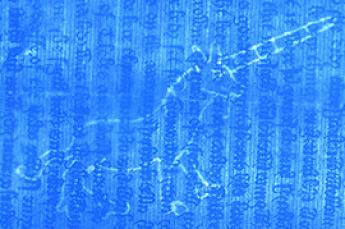Website
The Gravell Watermark Archive: Taking watermarks online

By Erica Olsen
The Gravell Watermark Archive (www.gravell.org) is bringing together more than 50,000 watermarks from America and Europe, including 7,500 images collected by American-watermark expert Thomas L. Gravell and about 45,000 unpublished marks documented by Charles-Moise Briquet. On the website, you can search for stags, swans, or unicorns, creatures from a medieval bestiary produced long ago by wire attached to a paper mould. (Watermarks are made by placing a design made with thin wire on a paper mould. The paper formed over the wire is thinner and translucent when held up to a light source.)
Watermarks identify paper as the product of a particular maker or mill at a particular place and time. Watermarks were short-lived. Exposed to water and pulp, a mould might last a year, a watermark half that. There is no comprehensive catalog of them. But for the researcher hoping to date a manuscript, print, or map, watermarks offer a starting point and sometimes an answer.
With so many designs out there, finding a match can seem almost as unlikely as spotting an actual unicorn. Projects such as the Gravell website are improving the odds by making a large quantity of data available to anyone who is interested—librarians, archivists, collectors, dealers, and researchers in literature, history, and a host of other fields.
In the 1970s, Gravell, a longtime DuPont employee in Delaware, was looking for a better way to study the watermarks in his stamp collection. Beta radiography produced high-quality images by sending carbon-14 radiation through paper onto film, but the process was expensive and took several hours. And working with radioactive materials had its drawbacks. Most people settled for tracing, a cheap but less accurate method.
Gravell experimented with a new photosensitive paper, Dylux 503, that DuPont had developed for use in the printing industry. The Dylux coating turns white when exposed to visible light and blue when exposed to ultraviolet. Gravell put Dylux under watermarked paper and exposed it to fluorescent light. More light passed through the watermark, the thinnest part of the paper. Then Gravell exposed the Dylux to ultraviolet light, which turned the paper blue, while leaving the watermark white. His method produced an inexpensive, accurate image in about five minutes.
Researching at the Library of Congress, the Folger Shakespeare Library, and other institutions, Gravell became an authority on watermarks. With George Miller, he wrote a book on American watermarks (1979; revised edition, Oak Knoll Press, 2002). Gravell’s slides and his notes are housed at the University of Delaware Library.
In 1995, Gravell and the University of Delaware Library partnered with Virginia Tech’s Center for Applied Technologies in the Humanities to put the collection online. Daniel W. Mosser and Ernest W. Sullivan II of the Virginia Tech English Department and Len Hatfield of the Center for Applied Technologies led a project to scan Gravell’s slides and enter his notes into an HTML database. Image software improved the contrast of the images and cleaned up their characteristic “type clutter.” (Unlike beta radiography, the Dylux method picks up print.) The database went live in 1996. Filigranology, the study of watermarks, had entered the digital era.
Version 2.0, rooted in a FileMaker Pro database, soon followed. And Gravell 3.0, a MySQL platform, launched in 2007. Mosser and Sullivan say a move to an XML database is likely; image search is desirable but not yet feasible. As the project has grown, the goal, according to Mosser, has remained consistent: “to make information freely and widely available that will enable users to identify paperstocks, to date them, to authenticate materials of questionable provenance, and to determine sources for paper supplies.”
John Bidwell, the Astor Curator of Printed Books and Bindings at the Morgan Library & Museum, comments that it was an “inspired idea to put Gravell’s watermarks on the web in easily searchable form. Americanists will be particularly glad to know about Gravell and Miller’s watermarks, which will help them to date and localize manuscripts, printed books, and art on paper.”
What lies ahead for watermarks on the web? As social networks link more people in the book world, one can imagine user-uploaded content and user-generated tags providing more ways to search. Mosser pointed out, “One editor’s shield might be another’s post horn, for example, but being able to search a database for either or both those descriptors betters one’s chances of success.”
The Gravell archive is a work in progress, a story of innovation building on innovation, back to the day when a thirteenth-century papermaker first attached a bit of wire to his mould.
Erica Olsen is a freelance writer and an archivist. This article originally appeared in Fine Books & Collections. It is presented here by permission of the author and Fine Books & Collections. Image credit: Thomas L. Gravell Watermark Archive, DYLUX Reproduction. Courtesy of the Folger Shakespeare Library
